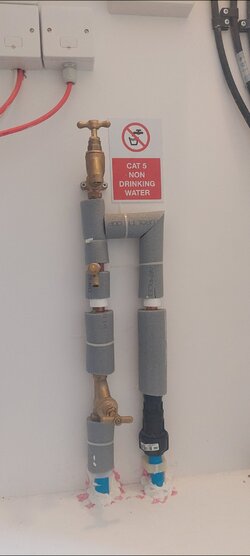- Reaction score
- 388
You are using an out of date browser. It may not display this or other websites correctly.
You should upgrade or use an alternative browser.
You should upgrade or use an alternative browser.
- Thread starter newfutile
- Start date
-
- Tags
- conductive parts
Discuss Extranous conductive parts in the UK Electrical Forum area at ElectriciansForums.net
- Reaction score
- 5,604
Well that's an unfortunate figure to get!!
Smack on the limit of what is classed as an extraneous conductive part (ECP)
I believe the resistance to earth of the suspected extraneous conductive part should actually be greater than 22K ohms between the suspected ECP and the MET of the CU (or nearest known verified connection to earth) (i.e 0.022M ohms), therefore yes, it is an ECP. Also, from certain literature I've read you could add on a factor of safety, bringing the value up to perhaps 25K, meaning your suspected part is definitely ECP.
It's a bit odd how it can test as low as 22K though, as you can clearly see both pipes being fed by plastic. Are there any other metal pipes coming off from those pipes, perhaps going straight into the wall, maybe hidden behind the insulation of the pipes?
Also, I cant see where your leads are attached to. What have you got the 2 leads attached to? Just noticed you say one end is attached to the CU. If the Cu is painted or has some kind of coating, this will affect the result drastically. I'd be opening the CU up and attaching to the MET (as long as you are an electrician).
Smack on the limit of what is classed as an extraneous conductive part (ECP)
I believe the resistance to earth of the suspected extraneous conductive part should actually be greater than 22K ohms between the suspected ECP and the MET of the CU (or nearest known verified connection to earth) (i.e 0.022M ohms), therefore yes, it is an ECP. Also, from certain literature I've read you could add on a factor of safety, bringing the value up to perhaps 25K, meaning your suspected part is definitely ECP.
It's a bit odd how it can test as low as 22K though, as you can clearly see both pipes being fed by plastic. Are there any other metal pipes coming off from those pipes, perhaps going straight into the wall, maybe hidden behind the insulation of the pipes?
Also, I cant see where your leads are attached to. What have you got the 2 leads attached to? Just noticed you say one end is attached to the CU. If the Cu is painted or has some kind of coating, this will affect the result drastically. I'd be opening the CU up and attaching to the MET (as long as you are an electrician).
Last edited:
- Reaction score
- 8,765
THIS ^^^^t's a bit odd how it can test as low as 22K though, as you can clearly see both pipes being fed by plastic. Are there any other metal pipes coming off from those pipes, perhaps going straight into the wall, maybe hidden behind the insulation of the pipes?
I'd be looking at that and thinking "How?!"
(a very idle thought - has the left hand screw for the tap grazed a cable?!)
He did the right test, detailed in Guidance Note 8.I'm guessing you used a megger tester to get that reading? Most normal testers would have given you the result in ohms or kiloohms, not as a fraction of a megaohm ..... If you did then do the test again using a multimeter.
- Reaction score
- 5,604
Thinking outside the box...
Perhaps it's the actual water that's causing the low resistivity?
Here's an extract detailing what cat 5 water may contain..
"Fluid category 5 (CAT 5) is described as a fluid representing a serious health hazard because of the concentration of pathogenic organisms, radioactive or very toxic substances. This includes any fluid which contains faecal material or other human waste, butchery or other animal waste, or pathogens from any other source."
Unfiltered tap water has a resistivity of between 1000ohms and 5000ohms (I think per meter). Dirty river water as low as 200ohms per meter (all found from the net, I'm not pretending I know this). So, I expect the resistivity of the cat 5 water is pretty low.
If the cat 5 water comes from another pipe nearby that is earthed, this may be the cause of the low IR reading. Very much on thin ice here though and I don't really understand all the implications. Interesting though.
Perhaps it's the actual water that's causing the low resistivity?
Here's an extract detailing what cat 5 water may contain..
"Fluid category 5 (CAT 5) is described as a fluid representing a serious health hazard because of the concentration of pathogenic organisms, radioactive or very toxic substances. This includes any fluid which contains faecal material or other human waste, butchery or other animal waste, or pathogens from any other source."
Unfiltered tap water has a resistivity of between 1000ohms and 5000ohms (I think per meter). Dirty river water as low as 200ohms per meter (all found from the net, I'm not pretending I know this). So, I expect the resistivity of the cat 5 water is pretty low.
If the cat 5 water comes from another pipe nearby that is earthed, this may be the cause of the low IR reading. Very much on thin ice here though and I don't really understand all the implications. Interesting though.
- Reaction score
- 5,806
Does the tap get used a lot, and water splashed about when it is? Interesting to try a damp meter on the wall.
Someone who actually knows what they’re doing.
The amount of sparks I know that assume plastic pipe = doesn’t need bonding, just because it says in the regs. You should always test the pipes because you can’t guarantee that they don’t shoot back into the ground within the installation
The amount of sparks I know that assume plastic pipe = doesn’t need bonding, just because it says in the regs. You should always test the pipes because you can’t guarantee that they don’t shoot back into the ground within the installation
- Reaction score
- 148
- Reaction score
- 388
Its not always a good idea to bond regardless , this is why i do test from the met (in the cu ) to the suspected part , as far as i know the water is not used and is actually turned off from a lower stop cock , it seems a funny place to have a water supply of any type (under the stairs in communal area).
i will pull some insulation off and see if there are any T’s , i think the water if fed from a tank in the bin store , so not drinkable
i will pull some insulation off and see if there are any T’s , i think the water if fed from a tank in the bin store , so not drinkable
- Reaction score
- 5,604
That was interesting.
I wonder where the figure of 1000Ω - 5000Ω of resistivity per meter for household water comes from then? I'm guessing the fact that John takes the measurement from the pipes and not the actual water means that it will not be in the 1K - 5k region, but I can't see why it is so much higher, i.e 190K.
- Reaction score
- 148
I think it may depend on the ions present in tap water which may vary from area to area. Distilled water has no conductivity.
- Reaction score
- 1,230
Are you sure those figures are "per meter"?.Some sites give similar resitivity readings (researchgate.net) "per centimeter".JW,s readings would naturally be a hundred times higher and add significantly to the overall resistanceThat was interesting.
I wonder where the figure of 1000Ω - 5000Ω of resistivity per meter for household water comes from then?
His readings are from the "actual water".The copper ends that the leads are attached to would have no effect on the resistance readingsI'm guessing the fact that John takes the measurement from the pipes and not the actual water
- Reaction score
- 1,683
Come on chaps, basic physics here !
Resistivity is the resistance between opposite faces of a cube of the substance. You can make the cube whatever size you like and you get the same value.
For a 1/2" (15mm) pipe, the cross sectional area is 174sq mm, so roughly 17.4cm of pipe will equate to the resistivity figure.
1 metre of that pipe will measure 100/17.4 = 5.7 times the resistivity etc.
At least that was taught to me over 50 years ago - maybe it's all changed now
PS I haven't watched the video yet so maybe that says different??!
Resistivity is the resistance between opposite faces of a cube of the substance. You can make the cube whatever size you like and you get the same value.
For a 1/2" (15mm) pipe, the cross sectional area is 174sq mm, so roughly 17.4cm of pipe will equate to the resistivity figure.
1 metre of that pipe will measure 100/17.4 = 5.7 times the resistivity etc.
At least that was taught to me over 50 years ago - maybe it's all changed now

PS I haven't watched the video yet so maybe that says different??!
- Reaction score
- 2,833
I don't think this is correct Avo. By my calculations, a larger cube will always have a lower resistance across the faces?You can make the cube whatever size you like and you get the same value.
- Reaction score
- 5,806
Square, not cube.
........
........
- Reaction score
- 1,683
Ah yes. Memory fail again!Square, not cube.
........

Reply to Extranous conductive parts in the UK Electrical Forum area at ElectriciansForums.net
Similar Threads
During an EICR I have found an isolator with no cpc present bolted to a large metal post and all the motorized metal car park gate, the fact that...
- Replies
- 22
- Views
- 3K
As above the chest level from ground ,metal ANPR housing has no connection to earth ,it has monitors modems and a camera inside with a 230 volt...
- Replies
- 2
- Views
- 653
TNC-S main supply with 16mm swa supplying garage consumer unit from main consumer unit in house, then 4mm swa supplying pond equipment through...
- Replies
- 36
- Views
- 3K
Hello,
Carrying out remedial work on a commercial site and I've come across a metal out building that has a water supply to it. The water pipe...
- Replies
- 6
- Views
- 1K
- Question
Hi there, I’m a new member to the forum and felt like I could do with some additional insight into a fault I came across on a call-out at the...
- Replies
- 6
- Views
- 430
OFFICIAL SPONSORS








These Official Forum Sponsors May Provide Discounts to Regular Forum Members - If you would like to sponsor us then CLICK HERE and post a thread with who you are, and we'll send you some stats etc
YOUR Unread Posts
-
-
C.K VDE Interchangeable Slim Bladed Screwdriver Set
- Latest: AngelLaHash
-
Electrical Forum
Welcome to the Electrical Forum at ElectriciansForums.net. The friendliest electrical
forum online. General electrical questions and answers can be found in the electrical forum.
This website was designed, optimised and is hosted by Untold Media. Operating under the name Untold Media since 2001.



